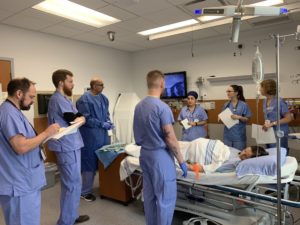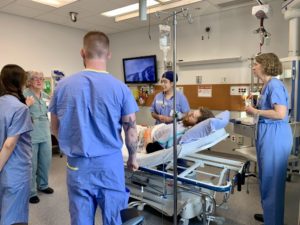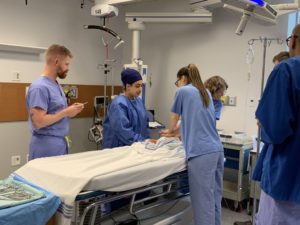Prince George BC welcomes the first Canadian VAST Course
Thank you to all involved in the most recent VAST Course in Prince George, British Columbia. This is a fantastic moment for the team behind VAST, seeing it delivered in a drastically different setting. Please read Dr Patty Livingston’s reflections on the course.
Prince George in November: crisp air, snow-covered ground crunching underfoot, evergreens, bright red berries and unique light – soft, almost mystical, with dramatic pinks and blues in the late afternoon. Nighttime moose encounters are a threat to drivers, who choose robust high-set trucks for safety.

Prince George is a hub for northern British Columbia. Fourteen years ago, the University of British Columbia established the Prince George medical school campus with the goal of preparing future doctors to serve in rural and northern communities. Previously, students trained in Vancouver and accustom to the big city context they rarely returned to the north. Now they learn in a setting that reflects the local needs. Trainees are often placed for extended periods in communities further afield, in small family practices in the interior and north. It was a rare and pleasant surprise to hear learners say their career aspiration is rural family medicine. We have come to Prince George to teach the Vital Anesthesia Simulation Training (VAST) Course.
Simulation-based health professional education is widespread in high-resource settings, but it typically requires expensive mannequins, a simulation laboratory and technical expertise to run the equipment. The innovation of VAST is to create high quality, authentic clinical scenarios with simple technology, minimal equipment and human actors. The scenarios feel quite real and require learners to respond accordingly. Course participants manage commonly encountered clinical situations (e.g., urgent laparotomy, obstetrics, pediatrics, trauma, pain management) and learn non-technical skills for effective team working. Through simple portable methods, VAST creates an immersive, emotionally charged environment where participants have good “buy in” or credibility. The course is designed to be inter-professional and scalable to learners through fundamental, intermediate and advance levels of many scenarios. After running four VAST Courses in both rural and urban Rwanda, we were eager to explore a completely different context.
 Our teaching group comprises Angela (an anesthesiologist and expert who has taught multiple courses around the world, including the recent VAST Course in Nyagatare, Rwanda), Lisa (global health coordinator), Julian (Prince George anesthesiologist and lead for the CASIEF Ethiopia program) and me (Patty, VAST co-author, teacher of VAST in Rwanda and former CASIEF Rwanda program lead). Our goal in offering VAST in Prince George is two-fold: to test VAST in a semi-rural Canadian context and to prepare Julian for facilitating the VAST Course in Addis Abba, Ethiopia in January.
Our teaching group comprises Angela (an anesthesiologist and expert who has taught multiple courses around the world, including the recent VAST Course in Nyagatare, Rwanda), Lisa (global health coordinator), Julian (Prince George anesthesiologist and lead for the CASIEF Ethiopia program) and me (Patty, VAST co-author, teacher of VAST in Rwanda and former CASIEF Rwanda program lead). Our goal in offering VAST in Prince George is two-fold: to test VAST in a semi-rural Canadian context and to prepare Julian for facilitating the VAST Course in Addis Abba, Ethiopia in January.
The simulation centre in Prince George is well equipped and the staff are helpful. We had brought the core printed materials: course manuals, handbooks for participants, scenario role-play instruction cards, patient documentation (e.g., vital sign observation charts, anesthesia records, progress notes) and photographs of pathology to be discovered during patient examination. The Prince George simulation centre provided the remainder of the materials and a few simple mannequins. We spent the first two days setting up our workspace and running through scenarios to help Julian become familiar with VAST Course facilitation. This was useful for all of us and essentially offered a dress rehearsal before the learners arrived.
Angela and I had previously experienced VAST in a remote district hospital in Rwanda where the challenges were many: participants had to travel hours in the rain to arrive, people had little capacity in English, a hotel venue with abundant ambient noise and learners with no prior simulation experience. In contrast, Prince George was easy. The attendees included one anesthesiologist, one anesthesia assistant and four medical students. They arrived on time, fluent in English, with previous simulation experience and a high level of training. We quickly discovered that we could offer the intermediate and advanced levels of many scenarios. Because of everyone’s schedules, we condensed the course to two days rather than the usual three-day course. Despite this, we needed to omit little because the learning was smooth and efficient.
The course was received with great enthusiasm and appreciation. Indeed, the learners commented that interacting with simulated patients created much more buy in than they had previously experienced with expensive plastic mannequins. Credibility was such that we nearly had to stop one of them from intubating a colleague!

At the post-course dinner, kindly hosted by Julian and his wife, the learners asked to be involved in future VAST Courses and suggested specific communities they thought would be ideal. One medical student from Yukon thought there would be great value for the course in northern Canada. Others thought the course should be included widely in training programs and run for general practitioners. Our team left Prince George inspired by the value of this course in Canada and keen to implement it widely in both teaching hospitals and more remote settings.

